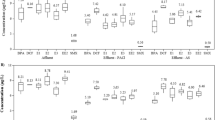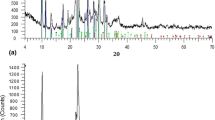Abstract
Methylparaben (MeP) and Propylparaben (PrP) are widely used in consumer products and their presence in surface, ground and waste water is a source of concern. They belong to category 1 of the Endocrine Disrupter Priority List for wildlife and human health and hence, these compounds should be completely removed from drinking water in Water Treatment Plants (WTP). Adsorption with powdered activated carbon (PAC) is a solution to eliminate emerging pollutants (ECs), as occurs in Benidorm WTP; however, it is necessary to know the conditions for the removal of these compounds and to optimize its application achieving lower economic costs. With this aim, the process has been characterized studying the adsorption equilibrium and kinetics in single and bicomponent batch experiments, using the commercial carbon Pulsorb PWX HA. The individual adsorption of MeP and PrP by PAC suits an “L” isotherm, according to Giles’ classification. The Langmuir and Freundlich models properly described the adsorption of MeP and PrP in monocomponent experiments. On the other hand, the results from bicomponent experiments suggested the existence of competitive adsorption with lower adsorption capacities for MeP. The multicomponent model Ideal Adsorbed Solution (IAS)-Freundlich predicted with more accuracy the competitive adsorption. For both compounds, the kinetic studies fit the pseudo-second order model. Differences between the removal efficiencies of similar compounds, MeP and PrP, were observed with ultrapure and real water, regarding the PAC dose and the contact time. The removal by adsorption in WTP could be optimized considering the parameters determined in this research.










Similar content being viewed by others
References
Álvarez, S.: Tesis doctoral: Eliminación de contaminantes emergentes presentes en aguas mediante adsorción en lecho fijo. Madrid: s.n. (2014)
ASTM: Standard practice for determination of adsorptive capacity of activated carbon by aqueous phase isotherm technique. Issue ASTM D3860-98 (2008)
Avogadro. Molecular Builder/Editor. Application version 1.2.0. [Application used: January 2017]
Blanco, E., Casais, M., Mejuto, M., Cela, R.: Combination of off-line solid-phase extraction and on-column sample stacking for sensitive determination of parabens and p-hydroxybenzoic acid in waters by non-aqueous capillary electrophoresis. Anal. Chim. Actab. 647(1), 104–111 (2009)
Boehm, H.: Some aspects of the surface chemistry of carbon blacks and other carbons. Carbon 32, 759–769 (1992)
Carmalin, S.A., Eder, C.L.: Removal of emerging contaminants from the environment by adsorption. Ecotoxicol. Environ. Saf. 150, 1–17 (2017)
Connell, D.W.: Bioaccumulation of Xenobiotic Compounds. CRC Press, Boca Raton (1999)
Delgado, L., Charles, P., Glucina, K., Morlay, C.: The removal of endocrine disrupting compound, pharmaceutically activated compounds and cyanobacterial toxins during drinking water preparation using activated carbon. Sci. Total Environ. 435–436, 509–525 (2012)
Directive 2013/39/EU of the European Parliament and of the Council, of 12 August 2013, amending Directives 2000/60/EC and 2008/105/EC as regards priority substances in the field of water policy
Giles, C., Macewan, T., Nakhwa, S., Smith, D.: Studies in adsorption. Part XI. A system of classification of solution adsorption isotherms, and its use in diagnosis of adsorption mechanisms and in measurement of specific surface areas of solids. J. Chem. Soc. (1960). https://doi.org/10.1039/JR9600003973
Giles, C., Smith, D., Huitson, A.: A general treatment and classification of the solute adsorption isotherm I theorical. J. Colloid Interface Sci. 47(3), 755–765 (1974)
Li, A., Hsueh, J., Hong, P.: Removal of antieoplastic drugs cyclophosphamide, ifosfamide and 5-fluorouracil and a vasodilator drug pentoxifylline from wastewaters by ozonation. Environ. Sci. Pollut. Res. 22(1), 81–515 (2015)
Limousin, G., Gaudet, J.P., Charlet, L., Szenknect, S., Barthes, V., Krimissa, M.: Sorption isotherms: a review on physical bases, modeling and measurement. Appl. Geochem. 22, 249–275 (2007)
Meng, M., Wang, Z., Ma, L., Zhang, M., Wang, J., Dait, X., Yan, Y.: Selective adsorption of methylparaben by submicrosized molecularly imprinted polymer: batch and dynamic flow mode studies. Ind. Eng. Chem. Res. 51, 14915–14924 (2012)
Mohamed, E., Andriantsiferana, C., Wilhelm, A., Delmas, H.: Competitive adsroption of phenolic compounds from aqueous solution using sludge-based activated carbon. Environ. Technol. 32, 1325–1336 (2011)
Nam, S., Choi, D.J., Kim, S.K., Her, H., Zoh, K.D.: Adsorption characteristics of selected hydrophilic and hydrophobic micropollutants in water using activated carbon. J. Hazard. Mater. 270, 144–152 (2014)
National Center for Biotechnology Information (NCBI): PubChem Compound. Open Chemistry Database (2017). [Consulted: January 2017]. https://www.ncbi.nlm.nih.gov/
Ocaña-González, J.A., Villar-Navarro, M., Ramos-Payán, M., Fernández-Torres, R., Bello-López, M.A.: New developments in the extraction and determination of parabens in cosmetics and environmental samples. A review. Anal. Chim. Acta 858, 1–15 (2015)
Petersen, G., Rasmussen, D., Gustavson, K.: Study on enhancing the endocrine disrupter priority list with a focus on low production volumen chemicals. European Commission DG Environment. DHI Water & Environment (ENV.D.4/ETU/2005/0028r) (2007)
Salman, J.M., Abid, F.M., Muhammed, A.A.: Batch study for pesticide glyphosate adsorption onto palm oil fronds activated carbon. Asian J. Chem. 24, 5646–5648 (2012)
Seung-Woo, N., Dae-Jin, C., Seung-Kyu, K., Namguk, H., Kyung-Duk, Z.: Adsorption characteristics of selected hydrophilic and hydrophobic micropollutants in water using activated carbon. J. Hazard. Mater. 270, 144–152 (2014)
Sing, K., Everett, D.H., Haul, R.A.W., Moscou, L., Pierotti, R.A., Rouqerol, J., Siemieniewska, T.: Reporting physisorption data for gas solid systems with special reference to the determination of surface-area and porosity (recommendations 1984). IUAPAC Pure Appl. Chem. 4(57), 603–619 (1985)
Snyder, S., Adham, S., Redding, A.M., Cannon, F.S., DeCarolis, J., Oppenheimer, E.C., Wert, E.C., Yoon, Y.: Role of membranes and activated carbon in the removal of endocrine disruptors and pharmaceuticals. Desalination 202(1), 156–181 (2007)
Soni, M.G., Carabin, I.G., Burdock, G.A.: Safety assessment of esters of phydroxybenzoic acid (parabens). Food Chem. Toxicol. 43, 985–1015 (2005)
Sotelo, J., Ovejero, G., Rodríguez, A., Álvarez, S., García, J.: Analysis and modeling of fixed bed column operations on flumenquine removal onto activated carbon: pH influence and desorption studies. Chem. Eng. Res. Des. 228, 102–113 (2013)
Sotelo, J., Rodríguez, A., Álvarez, S., García, J.: Removal of caffeine and diclofenac on activated carbón in fixed bed column. Chem. Eng. Res. Des. 90, 967–974 (2012)
Srivastava, V.C., Mall, I.D., Mishra, I.M.: Equilibrium modelling of single and binary adsorption of cadmium and nickel onto bagasse fly ash. Chem. Eng. J. 117, 79–91 (2006)
Terasaki, M., Makino, M., Tatarazako, N.: Acute toxicity of parabens and their chlorinated by-products with Daphnia magna and vibrio fischeri bioassays. J. Appl. Toxicol. 29, 242–247 (2009)
Treybal, R.E.: Mass Transfer Operations. MC Graw Hill, New York (1980)
Acknowledgements
This study was partially financed by the Ministry of Economy and Competitiveness via the project “Combined treatments for degradation and removal of emerging pollutants in water” (CTM2013-46669-R). The authors are grateful to project “LIFE EMPORE” (LIFE15 ENV/ES/000598).The authors are also grateful to Water Treatment Plant of Benidorm for providing the activated carbon and information on the plant operation, and to Ana Cristina Martínez Cantos (Grant of the “Promoción de empleo joven e implantación de la garantía juvenil en I+D+I” of the “Plan Estatal de Investigación Científica y Técnica de Innovación 2013–2016”) and Vicente Cases López for their collaboration in this research. The manuscript has been improved according to the suggestions of the reviewers and the authors are very grateful.
Author information
Authors and Affiliations
Corresponding author
Additional information
Publisher's Note
Springer Nature remains neutral with regard to jurisdictional claims in published maps and institutional affiliations.
Electronic supplementary material
Below is the link to the electronic supplementary material.
Rights and permissions
About this article
Cite this article
Bernal-Romero del Hombre Bueno, M., Boluda-Botella, N. & Prats Rico, D. Removal of emerging pollutants in water treatment plants: adsorption of methyl and propylparaben onto powdered activated carbon. Adsorption 25, 983–999 (2019). https://doi.org/10.1007/s10450-019-00120-7
Received:
Revised:
Accepted:
Published:
Issue Date:
DOI: https://doi.org/10.1007/s10450-019-00120-7




